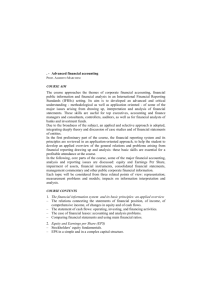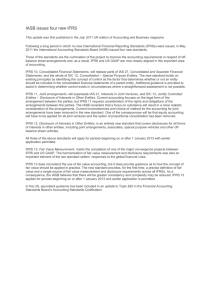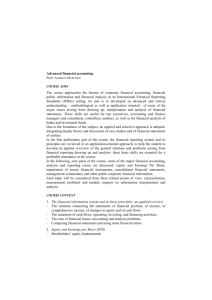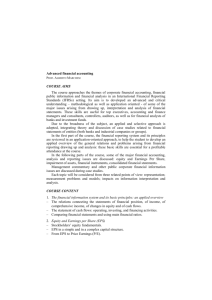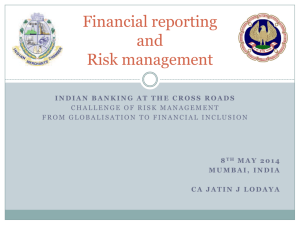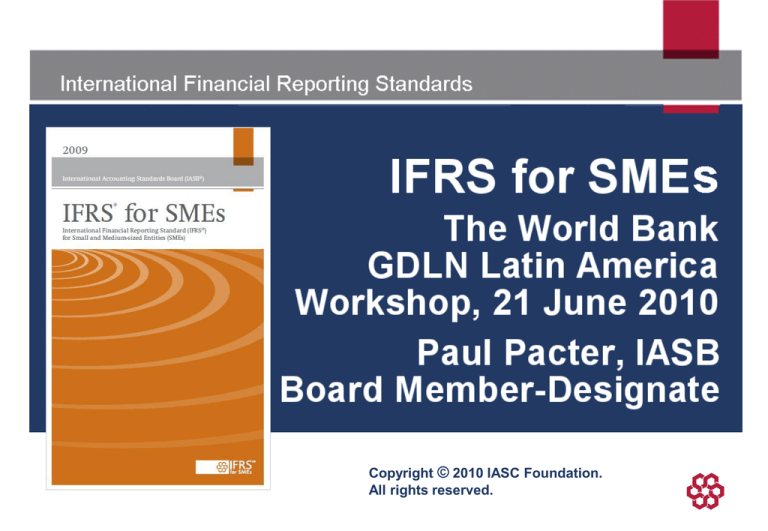
International Financial Reporting Standards
Copyright © 2010 IASC Foundation.
All rights reserved.
What I will cover this afternoon
•
•
•
•
•
•
•
2
Development of IFRS for SMEs
Adoption: Benefits. Country plans.
Translation and training
Implementation guidance
Review of all sections of the standard
Highlight key differences with full IFRSs
Your questions and comments
The IFRS for SMEs
Good Financial Reporting Made Simple.
• 230 pages
• Simplified IFRSs, but built on an IFRS
foundation
• Designed specifically for SMEs
• Internationally recognised
• Final standard issued 9 July 2009
• Vote: 13 assents, 1 dissent
3
Who will be eligible to use it?
4
Any entity that does not have public
accountability
–securities not publicly traded
–not a financial institution
• Over 99% of private entities around the world
are expected to be eligible to use the
standard
No quantified size test
– Though a jurisdiction could add one
Is it stand-alone or linked to full IFRS?
5
Completely stand-alone
• The only ‘fallback’ option to full IFRS is the
option to use IAS 39 instead of the financial
instruments sections of IFRS for SMEs
Steps to get to the final Standard
• Discussion Paper (2004), roundtables
(2005), exposure draft (2007), field tests
• Board deliberations at 44 public meetings
• Four working group meetings (40 experts)
• Translations of ED (5 languages)
• 7 Standards Advisory Council meetings
• 5 World Standard Setters’ meetings
• 145 staff presentations and roundtables in
50+ countries
6
How does it differ from full IFRSs?
• Tailored for SMEs
– User needs for cash flow information
– Costs and SME capabilities
• Much smaller (230 pages vs 2,855 in full
IFRSs)
• Organised by topic
• No ‘black letter’
• Simplifications from full IFRSs
7
How did we simplify?
8
1. Some topics in IFRSs omitted if irrelevant to
private entities
2. Where IFRSs have options, include only
simpler option
3. Recognition and measurement
simplifications
4. Reduced disclosures
5. Simplified drafting
Disclosure simplifications
9
• Big reduction in disclosures:
– Full IFRSs – more than 3,000 items in
the disclosure checklist
– IFRS for SMEs – roughly 300 disclosures
Kept: Disclosures about short-term cash flow,
liquidity, solvency, measurement uncertainties,
accounting policy choices
Dropped: Disaggregations, public capital
market disclosures
Why would an SME want to adopt it?
10
• Improved access to capital
– See research on next 2 slides
• Improved comparability
• Improved quality of reporting as compared to
existing national GAAP
• Less of a burden for entities in jurisdictions
where full IFRSs or full national GAAP are
now required
Why would an SME want to adopt it?
11
• “Transparency, Ownership, and Financing
Constraints in Private Firms” (Hope, Thomas, and
Vyas), November 2009
• Study: Around 31,000 small companies in 68
developing countries and emerging markets
• Abstract: We find that private firms with greater
financial transparency experience significantly
lower problems with gaining access to external
finance (and obtain those funds at a lower cost)
than do other private firms.
Why would an SME want to adopt it?
12
• “Financial Reporting Quality and Investment
Efficiency of Private Firms in Emerging Markets”
(Chen, Hope, and Li, November 2009)
• Study: Around 7,000 small companies in 20
emerging markets
• Abstract: We find strong evidence that
accounting quality positively affects investment
efficiency (i.e., is negatively related to both
underinvestment and overinvestment) for our sample
of relatively small private firms in lower-income
countries.
Support
13
World Bank press release July 2009:
“The IFRS for SMEs provides a valuable
financial reporting reference framework for
smaller entities that is more responsive to the
size and ownership of their operations, and
should help improve their access to finance. In
countries that have already adopted IFRS as the
national accounting standard, the simplifications
introduced by the SME standard will provide
much needed relief.”
Can SMEs simply choose to adopt it?
14
Depends on local law
• USA – yes. IASB is now the second
designated standard setter (along with
FASB) in the AICPA code of ethics.
• Other countries, adoption is “automatic” (law
already requires “IFRS”)
• In some countries, however, currently only
full IFRSs and local GAAP can be used.
Need to change local law or regs to permit
adoption of the IFRS for SMEs.
Jurisdiction plans for adoption
• Today (June 2010), to the best of our
knowledge:
– 61 jurisdictions have either adopted
the IFRS for SMEs or stated a plan to
adopt it within the next three years
– In nearly all cases IFRS for SMEs may
be used by all SMEs
– Some cases, as an option to full IFRSs
– Other cases, as an option to local
GAAP for SMEs
15
Jurisdiction plans for adoption
16
My understanding of Latin America/Caribbean
• Antigua / Barbuda - Require
• Argentina – Permit (exposure
draft issued)
• Bahamas – Require (adoption
expected June 2010)
• Barbados – Require (or full
IFRSs)
• Belize - Permit
• Brazil - Require or permit
(under study)
• Chile - Permit (under study)
• Costa Rica – Require
• Dominica - Require
• El Salvador - Require
• Guyana - Require (or full IFRS)
• Jamaica - Require for some
(now debating definition of SME)
• Montserrat - Require
• Nicaragua - Require
• Panama - Require (under study)
• Saint Kitts-Nevis - Require
• Saint Lucia - Require
• Trinidad and Tobago - Require
(or full IFRSs)
• Virgin Islands (US) – Permit
• Others: I need information
Jurisdiction plans for adoption
Other places:
• Africa: South Africa, Botswana, Egypt (proposal),
Namibia, Tanzania, Uganda, Ethiopia, Sierra
Leone
• Asia: Cambodia, Philippines, Hong Kong,
Malaysia (proposal). Singapore studying.
• Europe: UK (proposed), Ireland (proposed),
Turkey. Others studying. European Commission
is currently consulting on the IFRS for SMEs.
• Available for use without any action: United
States, Australia, Canada.
17
What would the audit report say?
18
• Something like:
•
“Fairly presents financial position, results
of operations, and cash flows in
conformity with the International Financial
Reporting Standards for Small and
Medium-sized Entities”
Plan for maintenance
19
• Initial comprehensive review after 2 years
implementation experience
– Fix errors and omissions, lack of clarity
– Also consider need for improvements based
on recent IFRSs and amendments to IASs
• Thereafter once every three years
(approximately) omnibus exposure draft of
updates
Plan for maintenance
20
Estimate of initial update:
– 2010 and 2011 first two years of experience
– 2012 begin review
– Both implementation problems and
consider changes to full IFRSs
– Invitation to comment 2012
– Exposure Draft 2012 or 2013
– Final amendments 2013
– 2014 earliest possible effective date of
amendments
– So, 4-5 year “stable platform”
Translations
• Complete or nearly complete:
– Chinese, Spanish, Italian, Portuguese,
Romanian
• In process:
– Arabic, Czech, French, Japanese,
Serbian, Turkish
• Proposed or in discussion:
– Armenian, Khmer, Macedonian, Polish,
Russian, Ukrainian
21
IASCF training materials for PEs
Being developed by IASC Foundation
• One module per Section. To illustrate:
• Section 17 PP&E is 7 A5 pages long
• Training module is 32 A4 pages, full text of
IFRS for SMEs with commentary on each
paragraph, many examples, cases, quiz,
comparison with full IFRSs
• 17 modules now posted. Rest in 2010
• Other languages in future (funding?)
• Free of charge – download
22
IASCF 3-day training workshops
23
“Train the trainers”
– Regional group or development agency organises
– IASCF/IASB provides trainers and materials (no
charge, just pay travel expenses)
– 3 days of intensive study covering most sections
of IFRS for SMEs
– Participants must commit to study the training
materials and do training in their home country
– Instruction in English (also plan Spanish and
Portuguese and others)
IASCF 3-day training workshops
24
“Train the trainers”
– All presentations used at the 3-day workshops
are posted on www.iasb.org
– You can download and develop your own training
programmes
SME Implementation Group
25
SMEIG being formed – two responsibilities:
• Consider implementation questions raised by users
of the IFRS for SMEs. Develop guidance in the
form of Q&As (non-mandatory guidance)
• Make recommendations to the IASB on, the need
to amend the IFRS for SMEs:
– For implementation issues that cannot be
addressed by Q&As; and
– For new and amended IFRSs that have been
adopted since the IFRS for SMEs was issued or
last amended
New IASB SME Newsletter
26
IFRS for SMEs Update:
•
•
•
•
•
Launched March 2010
Monthly
Free subscription via email
Staff summary of news relating to IFRS for SMEs
Links to IFRS for SMEs materials
Section by section highlights
27
The next 45 or so slides highlight the
requirements of the 35 sections of the IFRS
for SMEs and changes from the ED
• These are selective highlights
• Not complete summaries
Section 1 Small and medium entities
• Defines SME as used by IASB:
– not publicly accountable, and
– publish general purpose financial
statements for external users
• Listed companies may not use, no matter
how small
28
Section 2 Concepts and principles
• Objective: Information about financial
position, performance, cash flows
– Also shows results of stewardship of
management over resources
• Qualitative characteristics ― relevance,
reliability, etc
• Defines asset, liability, equity
• Defines income and expenses
29
Section 2 Concepts and principles
30
• Basic recognition concepts
• Basic measurement concepts
• Pervasive recognition and measurement
principles
– Source of guidance if a specific issue is
not addressed in the IFRS for SMEs
• Concepts of profit or loss and total
comprehensive income
• Principles for offsetting
Section 3 Financial statement presentation
31
• Fair presentation: presumed to result if
IFRS for SMEs is followed (maybe need for
supplemental disclosures)
• State compliance with IFRS for SMEs only if
the financial statements comply in full
• At least one year comparative financial
statements and note data
Section 3 Financial statement presentation
32
• Complete set of financial statements:
– Statement of financial position
– Either:
– Single statement of comprehensive income
– Two statements: Income statement and
statement of comprehensive income
– Statement of changes in equity
– Statement of cash flows
– Notes
Section 3 Financial statement presentation
Single Statement of
Comprehensive Income:
• Revenue
• Expenses:
–Finance costs
–P&L from associates / JVs
Tax expense
–Discontinued operations
• Profit or loss
• Items of Other
Comprehensive Income
• Total comprehensive
income
33
Two statements:
Income Statement:
• Bottom line is profit or
loss (as at left)
Statement of Comprehensive Income:
• Begins with profit or loss
• Items of OCI
• Bottom line is Total
Comprehensive Income
Section 3 Financial statement presentation
34
• Can present only an income statement (no
statement of comprehensive income) if no
items of other comprehensive income (OCI)
• The only OCI items under IFRS for SMEs
are:
– Some foreign exchange gains and losses
– Some changes in fair values of hedging
instruments
– Some actuarial gains and losses
Section 4 Statement of financial position
35
• May still be called “balance sheet”
• Current/non-current split is not required if
entity concludes liquidity approach is better
• Some minimum line items
• And some items that may be in the
statement or in the notes
• But sequencing, format, and titles are not
mandated
Section 5 Statement of Comprehensive
Income and Income Statement
36
• One-statement or two-statement approach
• Must segregate discontinued operations
• Must present “profit or loss” subtotal if entity
has items of other comprehensive income
IASB has agreed to drop the two-statement
approach in full IFRSs
Section 5 Statement of Comprehensive
Income and Income Statement
37
• If an SME presents consolidated financial
statements:
– Bottom line (Profit or Loss in the income
statement and Total Comprehensive Income
in the statement of comprehensive income)
is before allocating those amounts to noncontrolling interest and owners of the parent
Section 6 Statement of Changes in Equity
38
• Shows all changes to equity including
– total comprehensive income
– owners investments and withdrawals
– dividends
– treasury share transactions
• Can omit if no owner investments or
withdrawals other than dividends
– Instead: Statement of income and retained
earnings
Section 7 Statement of cash flows
39
• All SMEs must present a statement of cash
flows
• Option to use the
– indirect method, or
– direct method
to present operating cash flows
Section 8 Notes
40
• Disclose basis of preparation (ie IFRS for
SMEs)
• Summary of significant accounting policies
– Including information about judgements
and key sources of estimation uncertainty
• Supporting information for items in financial
statements
• Other disclosures
Section 9 Consolidation
41
• Consolidation is required when parentsubsidiary relationship – two exceptions:
– Sub was acquired with intent to dispose
within one year
– Parent itself is a sub and its parent or
ultimate parent uses full IFRSs or IFRS
for SMEs
• Basis of consolidation: control
– Consolidate all controlled SPEs
Section 10 Accounting policies
42
• If IFRS for SMEs addresses an issue, must
follow IFRS for SMEs
• If IFRS for SMEs does not address an issue:
– Choose policy that results in most relevant and
reliable information
– Try to analogise from requirements in the IFRS
for SMEs
– Or use concepts/pervasive principles in Sec 2
– May look to guidance in full IFRSs ─ but not
required
Section 10 Accounting policies
43
• Change in accounting policy:
– If mandated, follow the transition
guidance as mandated
– If voluntary, retrospective
• Change in accounting estimate: prospective
• Correction of prior period error: restate prior
periods if practicable
Section 11 Basic financial instruments
44
• Essentially, Section 11 is an amortised
historical cost model
– Except for equity investments with quoted
price or readily determinable fair value.
These are fair value through P&L.
• Option to follow IAS 39 instead of sections
11 and 12
– Even if IAS 39 is followed, make Section
11/12 disclosures (not IFRS 7
disclosures)
Section 11 Basic financial instruments
• Scope of Sec 11 includes:
–
–
–
–
–
Cash
Demand and fixed deposits
Commercial paper and bills
Accounts and notes receivable and payable
Debt instruments where returns to the holder
are fixed or referenced to an observable rate
– Investments in non-convertible and nonputtable ordinary and preference shares
– Most commitments to receive a loan
45
Section 11 Basic financial instruments
46
• Amortised cost – effective interest method
• Must test all amortised cost instruments for
impairment
• Reversal of impairment allowed
• Guidance on fair value and effective interest
method
• Derecognition
Criteria for basic instruments similar to IFRS 9.
No HTM or AFS – same as IFRS 9.
Section 12 Complex financial instruments
47
• Financial instruments not covered by Section
11 are at fair value through profit or loss. This
includes:
– Investments in convertible and puttable ordinary
and preference shares
– Options, forwards, swaps, and other derivatives
– Financial assets that would otherwise be in
Section 11 but that have “exotic” provisions that
could cause gain/loss to the holder or issuer
• Hedge accounting
Section 13 Inventories
48
• At cost, which may be
– specific identification for specialised items
– FIFO or weighted average for others
• Impairment (write down to estimated selling
price less costs to complete and sell)
Section 14 Associates
49
• Option to use:
– Cost model (except if published quotation
then must use Fair Value through P&L)
– Equity method
– Fair value through profit or loss loss (if
impracticable, then use cost)
Cost and FV models are not allowed by IAS 28
Section 15 Joint ventures
50
• Option to use:
– Cost model (except if published quotation
then must use Fair Value through P&L)
– Equity method
– Fair value through profit or loss (if
impracticable, then use cost)
• Proportionate consolidation is prohibited
Cost and FV models are not allowed by IAS 31.
Proportionate consol is allowed by IAS 31.
Section 16 Investment property
51
• If fair value can be measured reliably
without undue cost or effort, use Fair Value
through P&L
• Otherwise, must treat investment property
as property, plant and equipment using
Section 17
IAS 40 is pure accounting policy choice – either
depreciation model or fair value through P&L
Section 17 Property, plant & equipment
52
• Historical cost – depreciation – impairment
model only. No revaluation model.
IAS 16 allows reval of PP&E through equity
• Section 17 applies to investment property if
fair value cannot be measured reliably
• Section 17 applies to property held for sale
– Holding for sale is an impairment indicator
IFRS 5 requires separate treatment for noncurrent assets held for sale
Section 17 Property, plant & equipment
53
• Component depreciation only if major parts
of an item of PP&E have “significantly
different patterns of consumption of
economic benefits”
• Review useful life, residual value,
depreciation rate only if there is a significant
change in the asset or how it is used
IAS 16 requires annual review
• Impairment testing & reversal –Section 27
Section 18 Intangibles other than goodwill
• No recognition of internally generated
intangible assets
IAS 38 requires capitalisation of development
costs incurred after a determination of
commercial viability
54
Section 18 Intangibles other than goodwill
55
• Amortise intangibles that are purchased
separately, acquired in a business
combination, acquired by grant, and acquired
by exchange of other assets
• Amortise over useful life. If unable to
estimate useful life, then use 10 years
• Impairment testing – follow Section 27
Section 19 Business combinations & goodwill
• Acquisition method
• Amortise goodwill. If unable to estimate
useful life, then use 10 years.
• Impairment testing and reversal – follow
Section 27
• Negative goodwill – first reassess original
accounting. If that is ok, then immediate
credit to P&L
IAS 38 prohibits goodwill amortisation
56
Section 20 Leases
57
• Finance and operating lease classification
similar to IAS 17
• Measure finance leases at lower of FV of
interest in leased property and present value
of minimum lease payments
• For operating leases, do not force straightline expense recognition if lease payments
are structured to compensate lessor for
general inflation
IAS 17 requires straight-line recognition.
Section 21 Provisions & contingencies
58
• Accrue if an obligation arising from a past
event and amount can be estimated reliably
• Disclose (no accrual) contingent liability
• Measure at best estimate
– Large population – weighted average
calculation
– Single obligation – adjusted most likely
outcome
• Includes an appendix of examples
Section 22 Liabilities and equity
59
• Guidance on classifying an instrument as
liability or equity
– Instrument is a liability if the issuer could
be required to pay cash
– However, if puttable only on liquidation
then it is equity
Section 22 Liabilities and equity
• Section 22 also covers:
– original issuance of shares and other
equity instruments
– sales of options, rights and warrants
– stock dividends and stock splits
These topics are not addressed in full IFRSs
60
Section 23 Revenue
61
• Same principles as IAS 18 and IAS 11
– Goods: Revenue recognised when risks and
rewards are transferred, seller has no
continuing involvement, measurable
– Services and construction contracts:
Recognise by percentage of completion
• Principle for measurement is fair value of
consideration received or receivable
Section 24 Government grants
62
• All measured at the fair value of the asset
received or receivable
• Recognition as income:
– Immediately if no performance conditions
are imposed
– If conditions, recognise when conditions
are fulfilled
IAS 20 allows a wide range of methods of
accounting for government grants
Section 25 Borrowing costs
• All charged to expense when incurred
• No capitalisation
IAS 23 requires capitalisation of borrowing
costs relating to an asset during construction
63
Section 26 Share-based payment
• Must recognise
• Measure at fair value if practicable
• If it is impracticable to determine the fair
value of the option or other instrument
granted, the entity’s directors should use
their judgement to apply the most
appropriate valuation method
IFRS 2 has intrinsic value “simplification”
64
Section 27 Impairment of assets
65
• Inventories - write down to lower of cost and
selling price less costs to complete and sell,
if below carrying amount
• Other assets - write down to recoverable
amount, if below carrying amount
• Recoverable amount is the greater of fair
value less costs to sell and value in use
Section 28 Employee benefits
66
• For defined benefit plans, use projected unit
credit calculation only if entity is able without
undue cost or effort. Otherwise, can simplify:
– Ignore estimated future salary increases
– Ignore future service of current
employees (assume closure of plan)
– Ignore possible future in-service mortality
These simplifications are not in IAS 19
Section 28 Employee benefits
67
• Actuarial gains and losses may be
recognised in profit or loss or as an item of
other comprehensive income
– No deferral, including no corridor
approach
IAS 19 allows various options for deferring and
amortising actuarial gains and losses – though
IASB has proposed to eliminate those options
Section 29 Income tax
68
• Recognise deferred taxes if the tax basis of
an asset or liability is different from its
carrying amount
• Tax basis assumes recovery by sale. (If
zero capital gains tax, no deferred tax)
• No deferred tax on an asset or liability if
recovery or settlement of carrying amount is
not expected to affect taxable profit
Section 29 Income tax
• Exception: No deferred tax on unremitted
earnings of foreign subsidiaries and JVs
• Recognise deferred tax assets in full, with
valuation allowance
– Criterion is that realisation is probable
(more likely than not)
• Deferred taxes all non-current
Section 29 model is same as IASB/FASB March
2009 exposure draft on Income Tax
69
Section 30 Foreign currency translation
70
• Functional currency approach similar to that
in IAS 21
• No recycling of gains or losses on net
investment in a foreign entity that are initially
recognised in other comprehensive income
Section 31 Hyperinflation
• An entity must prepare general price-level
adjusted financial statements when its
functional currency is hyperinflationary
– Approximately greater than 100% over
three years
71
Section 32 Events after End of Reporting Period
72
• Adjust financial statements for events after
the balance sheet date that provide further
evidence of conditions that existed at the end
of the reporting period
• Do not adjust for events or conditions that
arose after the end of the reporting period
• Dividends declared after end of period are
not a liability
Section 33 Related party disclosures
73
• Government departments and agencies are
not related parties simply by virtue of their
normal dealings with an entity
• Disclosure of key management personnel
compensation only as one number in total
• Fewer disclosures about transactions
Section 34 Specialised activities
• Agriculture – use historical cost model
unless fair value is readily determinable
without undue cost or effort
• Oil and gas and mining – not required to
charge exploration costs to expense
74
Section 35 First-time adoption
75
• Prepare current year and one prior year's
financial statements using the IFRS for
SMEs
• But there are many exemptions for restating
specific items
• And a general exemption for impracticability
No sections covering these topics
•
•
•
•
Segment reporting
Earnings per share
Interim reporting
Assets held for sale
76
Questions or comments?
Expressions of individual views by members
of the IASB and its staff are encouraged.
The views expressed in this presentation are
those of the presenter.
Official positions of the IASB on accounting
matters are determined only after extensive
due process and deliberation.
© 2010 IASC Foundation | 30 Cannon Street | London EC4M 6XH | UK | www.iasb.org
77



